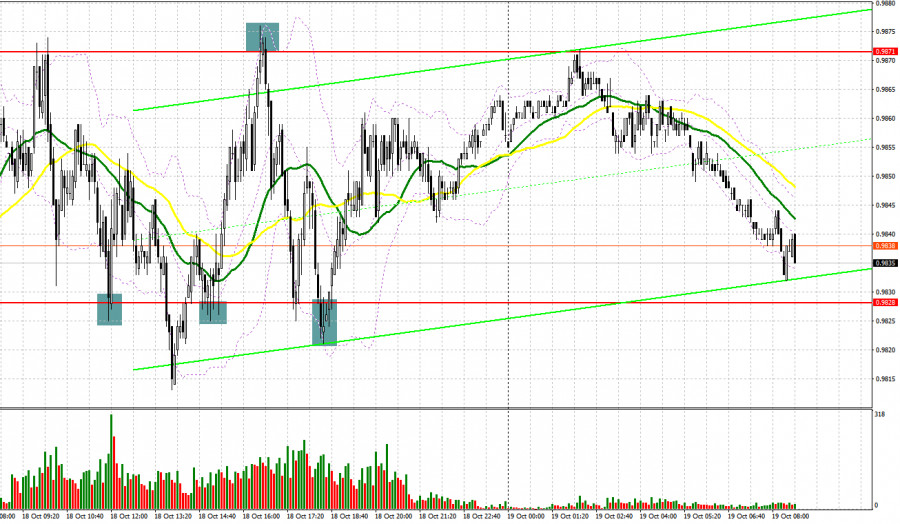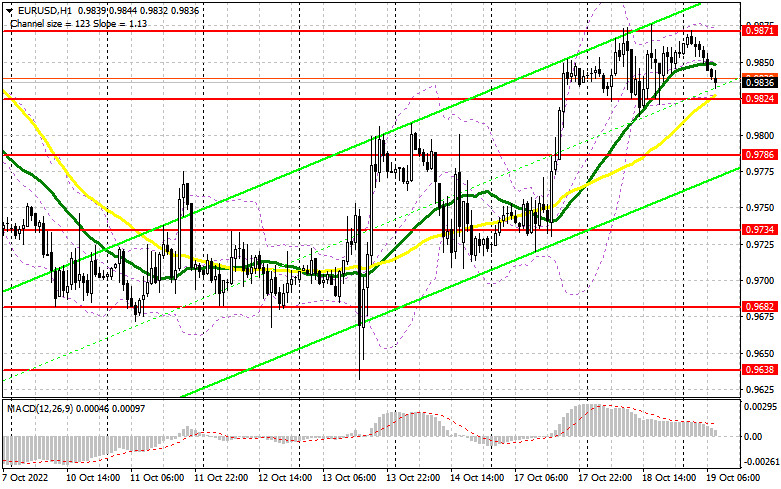
Several excellent market entry signals were formed yesterday. Let's take a look at the 5-minute chart and see what happened. I paid attention to the 0.9828 level in my morning forecast and advised making decisions on entering the market there. The decline and forming a false breakout after the release of weak data from the IFO Institute for Germany and the eurozone - all this led to a signal to buy the euro, however, after moving up by 20 points, the bulls' enthusiasm quickly dried up. In the afternoon, the bulls still managed to regain control of 0.9828, and the reverse downward test gave an excellent signal to buy, resulting in a 40-point increase to the 0.9871 area. There, the bears did not take long to wait, and after an unsuccessful attempt to consolidate above, a sell signal was formed with the euro's active movement back down to 0.9828.

A rather important indicator of inflation in the eurozone will be released today, which may exceed the level of 10.0%. And while this will not come as a surprise to the European Central Bank, the higher inflation in the euro area, the more likely it is that in the short term the demand for the euro will increase. High inflation will force the central bank to act more aggressively, or talk about such intentions. However, in the face of several unsuccessful attempts to break through 0.9871 following the results of yesterday, the bulls need to concentrate on protecting the immediate support of 0.9824, to which the euro is now gradually slipping. There are also moving averages, playing on the bulls' side. Forming a false breakout at this level will be an excellent reason to increase long positions with the prospect of a second recovery to 0.9871. It will be possible to talk about the bulls' attempts to maintain control over the market only after a breakthrough of this range and the test from top to bottom, which may take place during the release of the eurozone inflation report, because there will be no other reasons for this in the first half of the day. This will hit the speculative bears' stops and form a buy signal with the possibility of a push up to the 0.9917 area, which will strengthen the bullish trend seen since October 13th. An exit above 0.9917 will serve as a reason for growth to the area of 0.9948, where I recommend taking profits.
If the EUR/USD declines and there are no bulls at 0.9824, and this level has already been repeatedly tested by the bears throughout the day yesterday, the pressure on the euro will increase. This will lead to an expansion of the horizontal channel and a fall to the area of 0.9786, where the lower border of the rising price channel passes. The optimal decision to open long positions would be a false breakout at 0.9786. I advise you to buy EUR/USD immediately on a rebound only from 0.9734, or even lower - in the area of 0.9682 with the goal of an upward correction of 30-35 points within the day.
When to go short on EUR/USD:The bears need to break through below 0.9824 as quickly as possible if they expect to regain control of the market. However, we should not forget about the need to protect 0.9871. This resistance can be tested in the first half of the day after the release of reports on the consumer price index for September this year. The optimal scenario for opening short positions would be forming a false breakout at the level of 0.9871, similar to the one we observed yesterday. This will provide an excellent entry point for short positions, allowing a return to the lower border of the channel at 0.9824, from which the bears may start having problems again. Consolidating below this range, as well as a reverse test from the bottom up - a reason to continue selling EUR/USD in order to remove bullish stop orders and a larger fall to the 0.9786 area. The farthest target will be the area of 0.9734, where last week major players bought the euro after strong fundamental statistics on the US. I recommend taking profit there.
If EUR/USD moves up during the European session, as well as the absence of bears at 0.9871, the demand for the pair will increase, which will lead to a more powerful upward correction. In this case, I advise you not to rush into selling: I recommend opening short positions only if a false breakout is formed at 0.9917, by analogy with what I analyzed above. You can sell EUR/USD immediately on a rebound from the high of 0.9948, or even higher - from 0.9990 with the goal of a downward correction of 30-35 points.

The October 11 Commitment of Traders (COT) report logged a sharp decline in long positions and an increase in short ones: clearly, traders were preparing for inflation and retail sales data in the US. It is clear that the Federal Reserve is having a hard time dealing with rising consumer prices, as the September report clearly shows, where inflation slowed down only 0.1% compared to the previous reading. Notably, we haven't seen the euro sell-off below the parity level for a long time already. What is more, even the geopolitical situation and the key interest rate hike by the Fed will hardly push the price lower. That is why it is a good reason to start buying the euro in the middle term. The COT report unveiled that long non-commercial positions rose by 3,255 to 196,136, while short non-commercial positions rose by 2,928 to 158,637. At the end of the week, the total non-commercial net position remained positive and amounted to 37,499 against 43,682. This indicates that investors are taking advantage of the moment and continue to buy the cheap euros below parity, as well as accumulate long positions, counting on the end of the crisis and the pair's recovery in the long term. The weekly closing price decreased and amounted to 0.9757 against 1.0053.
Moving averages
Trading is conducted in the area of 30 and 50-day moving averages, which indicates market uncertainty.
Note: The period and prices of moving averages are considered by the author on the H1 chart, which differs from the general definition of the classic daily moving averages on the daily chart.
Bollinger Bands
In case of growth, the upper border of the indicator in the area of 0.9755 will act as resistance. In case of a decline, the lower border of the indicator around 0.9709 will act as support.
Description of indicatorsMoving average (moving average, determines the current trend by smoothing out volatility and noise). Period 50. It is marked in yellow on the chart.Moving average (moving average, determines the current trend by smoothing out volatility and noise). Period 30. It is marked in green on the chart.MACD indicator (Moving Average Convergence/Divergence — convergence/divergence of moving averages) Quick EMA period 12. Slow EMA period to 26. SMA period 9Bollinger Bands (Bollinger Bands). Period 20 Non-commercial speculative traders, such as individual traders, hedge funds, and large institutions that use the futures market for speculative purposes and meet certain requirements.Long non-commercial positions represent the total long open position of non-commercial traders.Short non-commercial positions represent the total short open position of non-commercial traders.Total non-commercial net position is the difference between short and long positions of non-commercial traders.